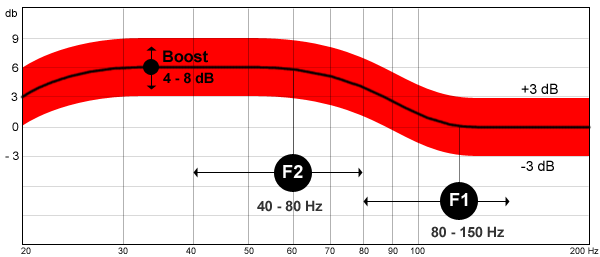A house curve is not a means of compensation for the ear’s decreases sensitivity at low volume levels, and has nothing to do with old-school loudness switches (which was a fix of sorts to compensate for the same). Rather, a house curve is compensation for the room. Every room is different so there is no “right” or universal house curve, but generally speaking smaller rooms sound better with a steeper low-end boost, whereas larger rooms can get away with less. A room has to be pretty big before it sounds natural with flat- or virtually-flat response. We’re talking small public auditoriums here.
The goal of a “proper” house curve, IMO, is to have all bass frequencies sound like they’re being generated at the same volume level, irrespective of what response measures. With measured flat response, a 30 Hz sine wave probably won’t sound as loud as one at 80 Hz. A little trick I came up with for determining a suitable house curve for a room is to play a sine wave at the crossover frequency of your subwoofer – 80-90 Hz typically – and a second at 30 Hz or so. If the 30 Hz signal sounds weak compared to the higher one, increase the level of the 30 Hz signal until it sounds like it’s the same volume as the higher frequency signal. At that point, the difference in measured SPL between the two signals is your house curve. E.g., 78 dB measured for the 90 Hz signal and 83 dB for the 30 Hz signal gets you basically a 5-dB slope. At that point, you would want to equalize response reasonably flat so that it slopes up 5 dB from 90 Hz to 30 Hz. The popular Room EQ Wizard program has a function that adds a house curve slope to your target curve for equalizing a subwoofer.
I’ve found that with the proper house curve in place, the only adjustment needed for different volume levels is to basically turn the sub up or down as needed. There’s no reason for a separate “low level” house curve and an “ear-bleeding loud” house curve. As I mentioned, the house curve is compensation for the room, not the ear.
The house curve shown in the first post didn’t sound good in my system. It’s not an upward slope from the high frequencies to the low, but merely an overall volume boost of a sub that’s equalized flat. Still, the main objective is coming up with something you think sounds good in your system. At the end of the day, it's purely subjective.
I wrote a treatise on the topic a number of years ago that might be of interest. I’m not sure if we’re allowed to post links from other forums here, but if you search “house curve” it should come up on the first page of most search engines.
Regards,
Wayne A. Pflughaupt



















